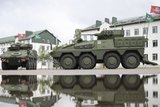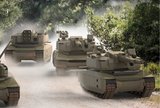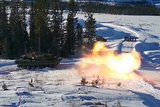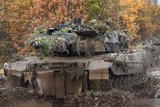US Army reveals Tactical Wheeled Vehicle Strategy
The US Army is preparing for the arrival of its Joint Light Tactical Vehicle (JLTV) and is looking to rebalance its fleet, as outlined in its 2011 Tactical Wheeled Vehicle (TWV) Strategy.
Released by the army on 27 January, the white paper says a combination of new procurement, sustainment, recapitalisation and divesture will be used to achieve the army’s TWV objectives for an ‘effective and affordable’ capability through to 2025.
In his introduction to the white paper, Lt Gen Robert Lennox, deputy chief of staff G-8, said the strategy would synchronise the efforts of all army agencies involved with the TWV fleet, which represents an investment of more than $70 billion.
‘With this strategy the army will field and sustain a modern TWV fleet that ensures our soldiers have the equipment they need,’ Lennox said.
The army’s TWV fleet is currently split into light, medium, heavy, and mine resistant ambush protected (MRAP) vehicles.
Despite having more than 19,000 MRAPs in four different categories and 19 variants, the Department of Defense intends to stop MRAP procurement once the current M-ATV and MaxxPro Dash contracts are completed, according to the report. The existing fleet is to be maintained for use in missions that require heavily protected vehicles.
The MRAP is currently not integrated into the army force structure, and one of the strategies outlined in the paper is to begin to document and incorporate them. The vehicles will serve as a bridge until JLTV comes into service.
The JLTV is currently in the technology development phase and low rate initial production is expected to start no earlier than 2015.
The report emphasises the importance of balancing TWV inventories across service components and ensuring the fleet is the right size and mix. An example is the High Mobility Multipurpose Wheeled Vehicle (HMMWV) LTV, which is described by the report as ‘out of balance in several areas’.
A rebalance will ensure: the fleet size is reduced as a means to achieve long-term affordability; it is an appropriate size; it is kept at an average age; it is deployed in the appropriate places.
The strategy also emphasises the significance of protected TWVs in the modern battlefield, saying ‘trucks must now be armoured, have the additional capacity and power to carry that armour, and be outfitted with a wide variety of command, control communications and computers, and intelligence, surveillance and reconnaissance equipment’.
As a result, vehicle costs have seen a steep increase, as has the requirement for armament.
An example of this provided by the paper is the HMMWV, which was originally unarmoured and introduced for light mobility at a cost of approximately $70,000. The army says it has increased the performance and protection of the HMMWV, and in turn the up-armoured variant now costs more than $160,000.
‘The army’s primary armour goal is to transition to a fleet that is capable of scalable protection,’ said the report. The TWV target for 2025 is to be 50% armour-capable to fulfil the requirements of all deployed forces.
The armour-level objectives are to move at a deliberately slow rate, and should the threat increase, the army will increase armour production in keeping with that threat. The army believes that by purchasing some armour each year it can continually improve the quality of its protection.
More from Land Warfare
-
![Hungary set to begin using Hero 400 loitering munitions]()
Hungary set to begin using Hero 400 loitering munitions
Developed by Israel's Uvision and with systems being sold in the thousands to multiple European NATO countries and the US, the Hero family of loitering systems is also in production in the US and Italy, the latter through Rheinmetall.
-
![Croatia orders Leopards and CAESAR howitzers as Lithuania orders more CAESARs]()
Croatia orders Leopards and CAESAR howitzers as Lithuania orders more CAESARs
The Leopard is becoming the tank of choice in central and eastern Europe as Croatia joins Lithuania, the Czech Republic and Hungary in ordering the platform. Lithuania and Croatia have also signed for CAESAR howitzers.
-
![Light Reconnaissance Strike – enabling a vital mission set (Studio)]()
Light Reconnaissance Strike – enabling a vital mission set (Studio)
A new system-of-systems concept will unlock digital integration of sensors and weapons for Light Forces, allowing them to shape the battlefield environment on their own terms and upgrade legacy platforms.






















